| Pages:
1
..
9
10
11
12
13
14 |
Fantasma4500
International Hazard
    
Posts: 1677
Registered: 12-12-2012
Location: Dysrope (aka europe)
Member Is Offline
Mood: dangerously practical
|
|
Pb(ClO4)2 easily made
i happen to have access to NH4ClO4
aswell as i can make PbCO3 very easily (lead acetate + sodium carbonate, filter)
i cant really spot anything that should make this reaction impossible (NH4ClO4 + PbCO3 > (NH4)2CO3 + Pb(ClO4)2)
what i like about this is that NH4ClO4 is by what i understand alot more safe to store and alot easier to buy, PbCO3 is pretty easy to make, and most
of all, the (NH4)2CO3 should decompose at ~60*C IN SOLUTION
i havent gotten around to do this.. yet...
i assume that it could possibly be explosive based on how Pb(ClO2)2 acts under heating, and also the fact that you shouldnt ever let a solution of
Pb(ClO4)2 dry out (small amounts, more control, more knownledge)
and if it wouldnt be explosive by itself, it should act as a brilliant oxidizer..
|
|
|
Xenoid
National Hazard
   
Posts: 775
Registered: 14-6-2007
Location: Springs Junction, New Zealand
Member Is Offline
Mood: Comfortably Numb
|
|
Quote: Originally posted by Antiswat  |
.... i cant really spot anything that should make this reaction impossible (NH4ClO4 + PbCO3 > (NH4)2CO3 + Pb(ClO4)2)
|
Well... other than the fact that lead carbonate is virtually insoluble (.00011g/100ml) that is... 
|
|
|
Eddygp
National Hazard
   
Posts: 858
Registered: 31-3-2012
Location: University of York, UK
Member Is Offline
Mood: Organometallic
|
|
Does anyone have an interesting way to start with lead(III) ions?
there may be bugs in gfind
[ˌɛdidʒiˈpiː] IPA pronunciation for my Username |
|
|
12AX7
Post Harlot
    
Posts: 4803
Registered: 8-3-2005
Location: oscillating
Member Is Offline
Mood: informative
|
|
Do you mean Pb(II) or Pb(IV)? And what are you starting exactly?
Lead doesn't have a +3 (unless there's some strange complex which exhibits it, but that's practically cheating).
Tim
|
|
|
Eddygp
National Hazard
   
Posts: 858
Registered: 31-3-2012
Location: University of York, UK
Member Is Offline
Mood: Organometallic
|
|
yes, I meant lead +3. Pb(III), and I know it is not common, but I thought there would be some sort of temporary stable compounds like hypomanganates,
which aren't always stable.
there may be bugs in gfind
[ˌɛdidʒiˈpiː] IPA pronunciation for my Username |
|
|
blogfast25
International Hazard
    
Posts: 10562
Registered: 3-2-2008
Location: Neverland
Member Is Offline
Mood: No Mood
|
|
AFAIK, no one here has attempted anything re. Pb (III).
|
|
|
KernelPicnic
Unregistered
Posts: N/A
Registered: N/A
Member Is Offline
|
|
Lead Dioxide
This afternoon I prepared some lead dioxide on a 100 mmol scale.
33g lead nitrate was dissolved in about 80mL warm distilled water. A mixture of 150mL 6% sodium hypochlorite and 25mL 10M sodium hydroxide was added
at once. Instantly, a bright orange precipitate was formed, which slowly began to darken in color. The reaction mixture was heated just below boiling
for about 15 minutes, until the precipitate turned a uniform dark brown. This was then gravity filtered and washed with ~400mL of tap water. The
filter cake was dried with a desk lamp for about four hours. Yield was 21g, or 88%.
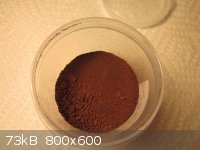
|
|
|
blogfast25
International Hazard
    
Posts: 10562
Registered: 3-2-2008
Location: Neverland
Member Is Offline
Mood: No Mood
|
|
Nice! With freshly prepared PbO2 you can make the interesting salt (NH4)2PbCl6 (ammonium hexachloroplumbate) which no one here seems to have attempted
yet. Adding chilled conc. H2SO4 to it liberates PbCl4 as a dark, heavy, oily liquid.
|
|
|
Heuteufel
Harmless

Posts: 25
Registered: 5-11-2011
Member Is Offline
Mood: No Mood
|
|
Well, I once made pyridiniumhexachloroplumbate (which is very similar to the ammonium salt) by saturating a suspension of lead(II)-chloride in HCl
with chlorine and precipitating the product with pyridine. Then I decomposed the pyridiniumhexachloroplumbate to PbCl4 with sulfuric acid:
Lead Tetrachloride
I don´t remember a procedure, that uses lead dioxide.
Something interesting might be to attempt a synthesis of lead tetraacetate with the PbO2 (usually red lead is used) and to use the product
afterwards to do a cleavage of an 1,2-diol, like for instance: Synthesis of n-butyl glyoxylate
|
|
|
blogfast25
International Hazard
    
Posts: 10562
Registered: 3-2-2008
Location: Neverland
Member Is Offline
Mood: No Mood
|
|
The following is from a *.pdf I picked up (I don't recall the url):
(b) Synthesis of (NH4)2PbCl6 from PbO2. It is imperative that the following reactions be performed in icecold
solutions. In a 50 mL beaker add a volume of saturated NH4Cl solution (10 mL), and in a 10 mL
beaker add concentrated (care!) HCl (5 mL). Cool both solutions thoroughly in ice. With the beaker
containing the HCl still in the ice bath, slowly add PbO2 (prepared above), with constant stirring (glass
rod); a yellow solution should be obtained. In some cases, a small amount of white precipitate will appear
at this stage; this does not influence the outcome of the reaction, however note its appearance and keep it
in mind when conducting the tests that follow. In the event that some white precipitate does appear after
adding all of the PbO2, leave the yellow solution in the ice bath for a few minutes so as to allow it to settle.
Next, quickly but carefully decant the yellow solution into the ice-cold NH4Cl solution (still in the ice
bath) with stirring, making sure to leave behind any white solid that may have previously appeared. Allow
the mixture to sit in the ice bath for several minutes in order to complete the precipitation, and then filter
the (NH4)2PbCl6 product (Buchner) from the mixture. Do not wash the product with water as it is very
soluble in this solvent. Allow the product to air dry (they may be stored in the locker until the next
laboratory session) and record the yield.
Fresh PbO2 is apparently quite soluble in concentrated HCl.
But your salt is interesting too.
[Edited on 24-3-2013 by blogfast25]
|
|
|
Heuteufel
Harmless

Posts: 25
Registered: 5-11-2011
Member Is Offline
Mood: No Mood
|
|
Hmm, interesting! I once made lead dioxide from lead(II)-nitrate using sodium persulfate as an oxidiser (I prefer this method to the hypochlorite
method) and I remember, I had serious problems cleaning the glassware particularly the glass frit I used for filtration. Cold HCl (37 %) had some
effect, but not much, heating the acid helped to some extent...
Therefore I am somewhat surprised, but I don´t say, that the procedure doesn´t work. I must also admit, that I did the synthesis some time ago and
thus my memories are somewhat vague...
|
|
|
DraconicAcid
International Hazard
    
Posts: 4278
Registered: 1-2-2013
Location: The tiniest college campus ever....
Member Is Offline
Mood: Semi-victorious.
|
|
Quote: Originally posted by Eddygp  | | yes, I meant lead +3. Pb(III), and I know it is not common, but I thought there would be some sort of temporary stable compounds like hypomanganates,
which aren't always stable. |
I'd be *very* surprised if you could make a stable lead(III) compound, as that would be a 6s1 electron configuration. The s electrons
(unlike the d electrons of manganese) usually come off as pairs.
Please remember: "Filtrate" is not a verb.
Write up your lab reports the way your instructor wants them, not the way your ex-instructor wants them.
|
|
|
blogfast25
International Hazard
    
Posts: 10562
Registered: 3-2-2008
Location: Neverland
Member Is Offline
Mood: No Mood
|
|
Quote: Originally posted by DraconicAcid  | | I'd be *very* surprised if you could make a stable lead(III) compound, as that would be a 6s1 electron configuration. The s electrons
(unlike the d electrons of manganese) usually come off as pairs. |
Sure, but there are plenty 'exceptions' to these simple 'rules'. There are electron deficient compounds too, see boranes e.g. But Ive never heard of
Pb(III).
|
|
|
DraconicAcid
International Hazard
    
Posts: 4278
Registered: 1-2-2013
Location: The tiniest college campus ever....
Member Is Offline
Mood: Semi-victorious.
|
|
Quote: Originally posted by blogfast25  | Quote: Originally posted by DraconicAcid  | | I'd be *very* surprised if you could make a stable lead(III) compound, as that would be a 6s1 electron configuration. The s electrons
(unlike the d electrons of manganese) usually come off as pairs. |
Sure, but there are plenty 'exceptions' to these simple 'rules'. There are electron deficient compounds too, see boranes e.g. But Ive never heard of
Pb(III). |
I suppose a diplumbane such as hexamethyldiplumbane would technically be lead(III), it's not an ionic compound. Neither Cotton & Wilkinson nor
Greenwood's Chemistry of the Elements mention lead(III) as a possible oxidation state (although they do mention the Zintl-type anions such as
Pb52-.
Please remember: "Filtrate" is not a verb.
Write up your lab reports the way your instructor wants them, not the way your ex-instructor wants them.
|
|
|
blogfast25
International Hazard
    
Posts: 10562
Registered: 3-2-2008
Location: Neverland
Member Is Offline
Mood: No Mood
|
|
Quote: Originally posted by DraconicAcid  | | I suppose a diplumbane such as hexamethyldiplumbane would technically be lead(III), it's not an ionic compound. Neither Cotton & Wilkinson nor
Greenwood's Chemistry of the Elements mention lead(III) as a possible oxidation state (although they do mention the Zintl-type anions such as
Pb52-. |
In hexamethyldiplumbane each Pb atom would share four electrons with other atoms: that's oxidation state IV by definition. The inter-Pb bond would
still be an orbital with shared elctrons.
[Edited on 25-3-2013 by blogfast25]
|
|
|
DraconicAcid
International Hazard
    
Posts: 4278
Registered: 1-2-2013
Location: The tiniest college campus ever....
Member Is Offline
Mood: Semi-victorious.
|
|
Quote: Originally posted by blogfast25  | Quote: Originally posted by DraconicAcid  | | I suppose a diplumbane such as hexamethyldiplumbane would technically be lead(III), it's not an ionic compound. Neither Cotton & Wilkinson nor
Greenwood's Chemistry of the Elements mention lead(III) as a possible oxidation state (although they do mention the Zintl-type anions such as
Pb52-. |
In hexamethyldiplumbane each Pb atom would share four electrons with other atoms: that's oxidation state IV by definition. The inter-Pb bond would
still be an orbital with shared elctrons.
[Edited on 25-3-2013 by blogfast25] |
I think that would be a valence of four by definition, but not an oxidation state.
Please remember: "Filtrate" is not a verb.
Write up your lab reports the way your instructor wants them, not the way your ex-instructor wants them.
|
|
|
Mailinmypocket
International Hazard
    
Posts: 1351
Registered: 12-5-2011
Member Is Offline
Mood: No Mood
|
|
Quote: Originally posted by blogfast25  |
The following is from a *.pdf I picked up (I don't recall the url):
(b) Synthesis of (NH4)2PbCl6 from PbO2. It is imperative that the following reactions be performed in icecold
solutions. In a 50 mL beaker add a volume of saturated NH4Cl solution (10 mL), and in a 10 mL
beaker add concentrated (care!) HCl (5 mL). Cool both solutions thoroughly in ice. With the beaker
containing the HCl still in the ice bath, slowly add PbO2 (prepared above), with constant stirring (glass
rod); a yellow solution should be obtained. In some cases, a small amount of white precipitate will appear
at this stage; this does not influence the outcome of the reaction, however note its appearance and keep it
in mind when conducting the tests that follow. In the event that some white precipitate does appear after
adding all of the PbO2, leave the yellow solution in the ice bath for a few minutes so as to allow it to settle.
Next, quickly but carefully decant the yellow solution into the ice-cold NH4Cl solution (still in the ice
bath) with stirring, making sure to leave behind any white solid that may have previously appeared. Allow
the mixture to sit in the ice bath for several minutes in order to complete the precipitation, and then filter
the (NH4)2PbCl6 product (Buchner) from the mixture. Do not wash the product with water as it is very
soluble in this solvent. Allow the product to air dry (they may be stored in the locker until the next
laboratory session) and record the yield.
Fresh PbO2 is apparently quite soluble in concentrated HCl.
But your salt is interesting too.
[Edited on 24-3-2013 by blogfast25] |
It would seem that fresh PbO2 is not strictly required... I used an old commercial source of it and followed the instructions you quoted above, with
nice results, just for fun
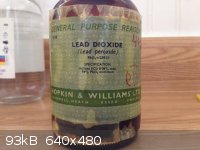
Dissolved 400mg PbO2 in 5ml conc. HCl, nice yellow solution was produced.
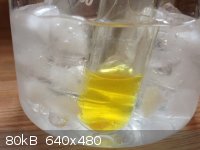
After dumping into ice cold saturated NH4Cl
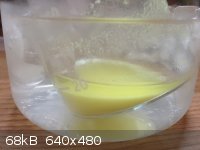
Filter cake...
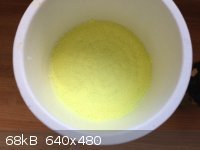
Product drying in a dish, final weight to be determined...
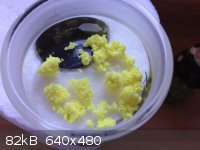
|
|
|
blogfast25
International Hazard
    
Posts: 10562
Registered: 3-2-2008
Location: Neverland
Member Is Offline
Mood: No Mood
|
|
Well, well, well, what a lovely confirmation there, MIMP, well done!
The yellow solution (second photo) must essentially be H2PbCl6 with excess HCl.
Now if you put some chilled conc. H2SO4 on dry, cold (NH4)2PbCl6 you should observe a dark oily liquid: PbCl4. Careful with that, I'm not sure how
stable it is!
The homologous (NH4)2SnCl6 also exists and is easy to synth too. Named 'pink salt' it was once an important dye mordant for bright pinks, like Pink
Madder or Cochenille.
[Edited on 26-3-2013 by blogfast25]
|
|
|
Mailinmypocket
International Hazard
    
Posts: 1351
Registered: 12-5-2011
Member Is Offline
Mood: No Mood
|
|
Quote: Originally posted by blogfast25  | Well, well, well, what a lovely confirmation there, MIMP, well done!
The yellow solution (first photo) must essentially be H2PbCl6 with excess HCl.
Now if you put some chilled conc. H2SO4 on dry, cold (NH4)2PbCl6 you should observe a dark oily liquid: PbCl4. Careful with that, I'm not sure how
stable it is! |
Well, I figured it would give me a reason to use my prehistoric bottle of PbO2! I'm thinking the same as you regarding the yellow solution, there was
also quite a bit of chlorine gas produced during the addition of PbO2 to the HCl but not intolerable in the small amounts used. The preparation
doesn't specify how much PbO2 was produced in "the previous experiment" and I got a little too spatula-happy and added too much. This resulted in a
mucky dark suspension, so I re started the experiment. In retrospect I could have just added more HCl but had a dumb moment and didnt think to do
so... Fail.
Otherwise it's pretty interesting to watch, when the PbO2 is added there is a vigorously fizzing dark liquid, and all of a sudden it clears to bright
yellow and you can continue adding in small amounts. Fun!
Once the product is completely dry I am definitely going to try the H2SO4 carefully, and take some pictures of the results.
*edit* just saw your comment about the tin pink salt, I will definitely give that a try too. I love making inorganic salts for some reason 
[Edited on 26-3-2013 by Mailinmypocket]
|
|
|
blogfast25
International Hazard
    
Posts: 10562
Registered: 3-2-2008
Location: Neverland
Member Is Offline
Mood: No Mood
|
|
Yes, these salts are quite satisfying to make. On the synth of 'pink salt' there's a thread of mine here somewhere. Search for 'hexachlorostannate',
if you're interested. It starts from pewter but you can start from tin or SnCl2 too.
|
|
|
KernelPicnic
Unregistered
Posts: N/A
Registered: N/A
Member Is Offline
|
|
I attempted to make K2PbCl6 using the same procedure for the ammonium salt, except obviously with saturated KCl. Nothing precipitated when I added the
PbO2/HCl, and only after sitting in the ice bath for about 30 minutes did a small amount of what looked like fine yellowish crystals drop out of
solution. It was kind of hard to tell since the color of the liquid was still bright yellow. I'm thinking the precipitate might just be PbCl2 from
partial decomposition. I'll try the ammonium salt whenever I get some NH4Cl.
[Edited on 27-3-2013 by KernelPicnic]
|
|
|
Mailinmypocket
International Hazard
    
Posts: 1351
Registered: 12-5-2011
Member Is Offline
Mood: No Mood
|
|
Quote: Originally posted by KernelPicnic  | I attempted to make K2PbCl6 using the same procedure for the ammonium salt, except obviously with saturated KCl. Nothing precipitated when I added the
PbO2/HCl, and only after sitting in the ice bath for about 30 minutes did a small amount of what looked like fine yellowish crystals drop out of
solution. It was kind of hard to tell since the color of the liquid was still bright yellow. I'm thinking the precipitate might just be PbCl2 from
partial decomposition. I'll try the ammonium salt whenever I get some NH4Cl.
[Edited on 27-3-2013 by KernelPicnic] |
If you can get some ammonia solution somewhere you could react that with the HCl you have and dry it out to get NH4Cl crystals
|
|
|
KernelPicnic
Unregistered
Posts: N/A
Registered: N/A
Member Is Offline
|
|
I've done that before, but with generic household ammonia the product turned out slightly yellow. I tried subliming it, but that never worked out very
well, and the result just looked worse, so I ended up throwing it away. Whatever impurities may have been in there probably wouldn't make a difference
anyway now that I think about it.
|
|
|
Mailinmypocket
International Hazard
    
Posts: 1351
Registered: 12-5-2011
Member Is Offline
Mood: No Mood
|
|
PbCl4
Just for a small test I added some conc. H2SO4 to a few small granules of (NH4)2PbCl6. There was an immediate reaction, and a cloudy yellow mix was
produced. The quantities used were so small that it was very difficult to see any oily substance, when I took a small sample out of the tube there was
obvious fuming in the air. I will be scaling it up now that I was able to see that the reaction is not terribly violent. Just need to wait to have my
fume hood back up and running before doing that.
Apologies for the small scale- it's a bit hard to see anything interesting and I wanted to have an obvious sample to show, but you get the idea! Ill
attach a video of the fuming nature of the liquid later on once YouTube "approves" it.
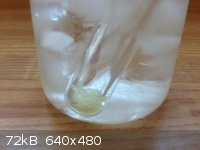 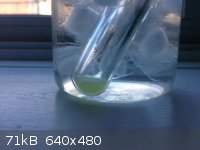
|
|
|
blogfast25
International Hazard
    
Posts: 10562
Registered: 3-2-2008
Location: Neverland
Member Is Offline
Mood: No Mood
|
|
Water and sulphates may be the enemy of this reaction, though. Water because PbCl4 hydrolyses easily, sulphates because of insoluble lead sulphates.
Better to 'keep your powder dry', as they say!
|
|
|
| Pages:
1
..
9
10
11
12
13
14 |